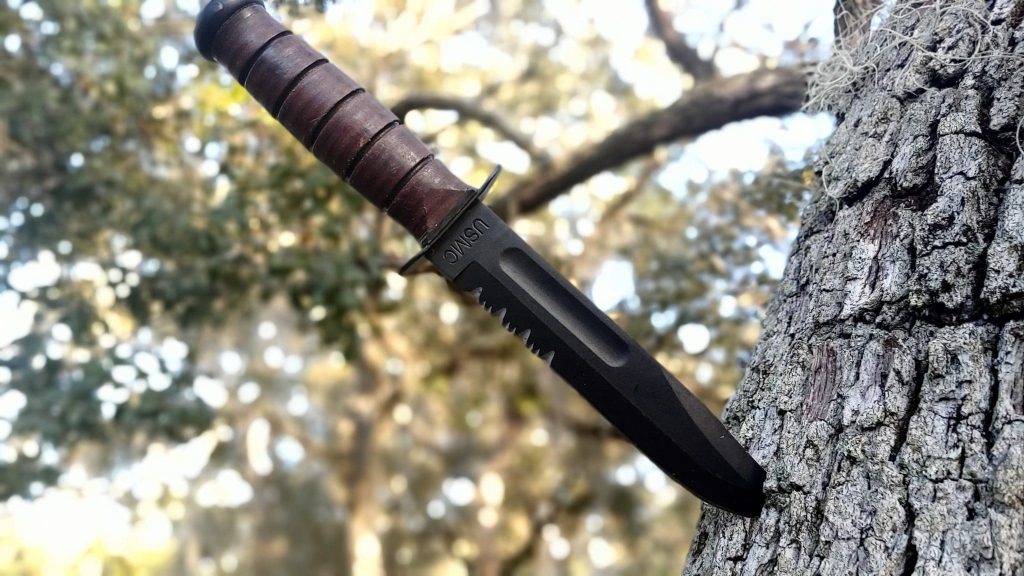
It’s always been fascinating to me how two things can become inexplicably tied together for decades and decades. My favorite example is the Ka-Bar and the United States Marine Corps. Call it my own time as a leatherneck, but it is fascinating how long the Ka-Bar has stuck around the Marine Corps. I remember being at a working party in the armory, and we had piles of Ka-Bar knives there. The armorer said they used to issue them to SAW gunners, but now everyone got a bayonet. My love of the Ka-Bar and the Marine Corps has led me down a road to uncover the origin of this fascinating relationship.
Ka-Bar – What’s In a Name
The story about how the Ka-Bar became Ka-Bar is pretty fascinating. It has some slight changes depending on who tells it. The basic story goes like this; the Union Cutlery Co. received a letter from a fur trapper sometime in the early 1920s. A bear attacked him, and his rifle malfunctioned, and he reverted to his Union Cutlery Co. knife. He slayed the bear, and in his letter, it was spelled K, a bar.
Some say the fur trapper was mostly illiterate. Others say the letter was damaged; whatever the real reason seemed confusing. The end result is that the phrase ka a bar meant to kill a bear, and Union Cutlery Co. ran with it. The phrase Ka-Bar wasn’t tied to the knife we associate with the Ka-Bar these days.

It was a ricasso stamp on a wide variety of knives, including tons of automatic folding knives. The knife used by the trapper wasn’t the famed Ka-Bar used by the Marine Corps. In fact, that knife wouldn’t come to be until 1942.
A Call To War
Any fighting done with knives today is extremely rare. However, in World War 2, it wasn’t exactly outside of the realm of possibility. The last world war saw plenty of melee combat, which spawned the Mark 1 Trench knife. The Mk1 was interesting but had issues. The blade was ultra-small land prone to breakage. It wasn’t useful as a utility knife. The brass knuckle fingerguard was expensive to make and forced a certain grip.

While that knife worked fine for WW1, the Navy, and Marine Corps needed a new knife. The Raider stiletto was great for fighting, but they wanted a tool that also acted as a utility knife. The Navy and Marine Corps looked at the market for fighting and utility knives and asked for submissions.
Colonel John Davis and Major Howard America (yep, that’s his name, meaning at one point he was Captain America.) began working with Union Cutlery Co to make improvements to the Western Cutlery Co. L77. The L77 was already a popular purchase among Marines heading to war, so it was a natural place to start.

From there, they lightened the blade, made it longer and stronger, used a pinned pommel, added a straight crossguard, and a stacked leather grip. This became known as the 1219C2 for some reason, and eventually would become known as both the US Navy Utility Knife Mk2 and the USMC Mk 2 Combat knife.
Into the Breach
Mk2 hit the Marine Corps with widespread acceptance. It became a weapon that they were quite fond of and became the standard amongst Marines. The raiders turned in their stilettos for Ka-Bars. The knife became famous for its utility and usefulness as well as its prowess in a fight.
The long blade made it easy to hit something vital from any angle and added good reach to the Marines’ thrust and slash. The “Knife, Fighting Utility” lived up to its name and then some. The Mk2 eventually just became known as the Ka-Bar. Then famous Ricasso stamp found its way onto a ton of the knives being produced.

Multiple companies produced the knife under contract during World War 2. Union Curley Co. wisely stuck with their markings, and this allowed their trademark to become an unofficial name for the famed Mk2. It’s the Kleenex of fighting knives.
The Ka-Bar Today
In 2023 the Ka-Bar is still associated with the Marine Corps. It’s become a symbol that is just part of the Corps’s work and will likely be forever intertwined with the Corps. When I was in the Ka-Bar was a common purchase by Marines.
It served through Korea, Vietnam, and the Global War on Terror. Marines carried the Ka-Bar nearly as often as they carried rifles. When we talk about fighting, the Ka-bar isn’t really a star of the show, but it’s not completely unheard of. In Vietnam, James Stogner killed several NVAs with a Ka-Bar after his rifle was disabled. In Fallujah, a marine met an insurgent on a stairway and started a brawl. They tangled with each other and were so close they couldn’t use their guns, but the Marine had his Ka-Bar.

The Ka-Bar still serves most as a utility knife. It’s a tough knife that can be used to cut, pry, hammer, and dig if necessary. It’s also an affordable option for the young Marine who doesn’t have a huge paycheck.
To this day, the bayonet issued to the Marine Corps is inspired by the Ka-Bar. It’s modified to be a bayonet with a slightly longer blade, and the serration comes on every model. The OKC-3S isn’t a standard Ka-Bar, but it’s undoubtedly influenced by the design. The blade design and handle are very Ka-Bar-like, and it’s easy to mistake one knife for another.



